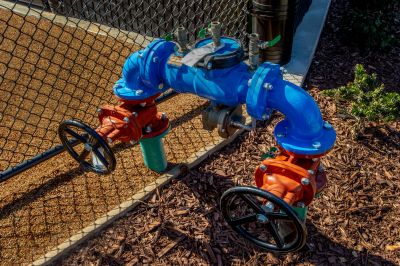Leading Backflow Plumbing Replacement Options For Professional Installations
Choose from professional-grade products designed for efficient installation and dependable backflow protection.
 Backflow plumbing replacements are essential components in maintaining the safety and functionality of plumbing systems, especially in areas where water could potentially flow backward into the main supply. These products are designed to prevent contamination and protect potable water sources by allowing water to flow in only one direction. When selecting backflow prevention devices, it is important to consider compatibility with existing plumbing infrastructure, ease of installation, and adherence to local plumbing codes. Various types of backflow prevention products are available to suit different needs, from simple check valves to more complex assemblies suitable for commercial applications.
Backflow plumbing replacements are essential components in maintaining the safety and functionality of plumbing systems, especially in areas where water could potentially flow backward into the main supply. These products are designed to prevent contamination and protect potable water sources by allowing water to flow in only one direction. When selecting backflow prevention devices, it is important to consider compatibility with existing plumbing infrastructure, ease of installation, and adherence to local plumbing codes. Various types of backflow prevention products are available to suit different needs, from simple check valves to more complex assemblies suitable for commercial applications.
Top Overall Option
Universal Backflow Preventer Assembly
A versatile and reliable backflow preventer assembly designed to fit a wide range of plumbing systems. It offers easy installation, durable materials, and compliance with standard safety regulations, making it suitable for residential, commercial, and industrial applications. Its modular design allows for straightforward maintenance and replacement of components, ensuring long-term performance.
Types of Products For Backflow Plumbing Replacements
Check Valves
Simple devices that allow water to flow in only one direction, preventing backflow in residential and commercial systems.
Reduced Pressure Zone (RPZ) Assemblies
Advanced devices that provide high-level backflow prevention, often used in irrigation and industrial settings.
Double Check Valve Assemblies
Dual check valves combined into a single assembly, suitable for low to moderate hazard situations.
Atmospheric Vacuum Breakers
Devices that prevent back-siphonage by allowing air into the system, typically used in hose bibs and irrigation.
Pressure Vacuum Breakers
Backflow preventers that use a spring-loaded mechanism to prevent siphoning, suitable for outdoor plumbing.
Spring-loaded Check Valves
Valves that use a spring mechanism to ensure unidirectional flow, often used in various plumbing applications.
Manual Shut-off Valves
Valves that allow manual control over water flow, useful during maintenance or system shutdowns.
Backflow Prevention Assemblies for Fire Systems
Specialized devices designed to protect fire sprinkler systems from backflow contamination.
Pipe Fittings and Adapters
Various fittings that facilitate the integration of backflow prevention devices into existing plumbing systems.
Testable Backflow Devices
Devices that can be tested for proper operation, often required by local codes for commercial systems.
Popular Choices
Widely used for preventing reverse flow in various plumbing setups, available in multiple sizes and materials.
Commonly selected for high-risk environments requiring strong backflow protection.
Frequently chosen for low hazard applications, offering reliable backflow prevention.
Popular for outdoor and irrigation use due to ease of installation and maintenance.
Often used in outdoor plumbing systems for their effectiveness against back-siphonage.
Common in various applications for their durability and reliable operation.
Popular for controlling water flow during maintenance or emergencies.
Frequently selected to protect fire protection systems from backflow contamination.
Essential for integrating various backflow devices into existing plumbing systems.
Often chosen for systems requiring regular testing and certification.
Upgrading or replacing backflow prevention devices can help ensure the ongoing safety of water supplies, reduce the risk of contamination, and improve overall system reliability. Proper installation and regular maintenance are crucial for optimal performance. Many products are designed for easy integration into existing plumbing setups, making upgrades more straightforward for both professional plumbers and experienced DIY enthusiasts. Understanding the specific requirements of your plumbing system will help in choosing the right product type, whether for residential, commercial, or industrial use.
In addition to basic check valves, there are specialized assemblies such as reduced pressure zone (RPZ) devices, double check valves, and atmospheric vacuum breakers. Each type offers different levels of protection and is suited for specific applications, such as irrigation systems, fire protection, or industrial water systems. When selecting a backflow prevention device, consider factors like water pressure, flow rate, and the nature of the fluid being controlled. Properly chosen and maintained products can contribute significantly to maintaining water quality and complying with health and safety standards.
Investing in quality backflow prevention products is a proactive step toward safeguarding your water supply. Whether for a small residential system or a large commercial setup, understanding the variety of available products and their specific functions can help ensure you select the most appropriate solution for your needs. Regular inspection and maintenance are recommended to keep these devices functioning correctly over time, preventing potential backflow issues and ensuring peace of mind for years to come.
Key Buying Considerations
- Compatibility with existing plumbing infrastructure and pipe sizes.
- Type of backflow prevention device suitable for your application (check valve, RPZ, double check, etc.).
- Flow rate and water pressure requirements to ensure proper operation.
- Material durability and resistance to corrosion or environmental factors.
- Ease of installation and maintenance, especially if DIY installation is intended.
- Compliance with local plumbing codes and safety standards.
- Availability of testing and certification options for system validation.
- Space constraints within the plumbing system for device installation.
- Cost considerations balanced with quality and reliability.
- Manufacturer reputation and product reviews for long-term performance.
- Compatibility with other system components such as valves or fittings.
- Type of fluid or water being controlled, especially if hazardous or contaminated.
- Frequency of maintenance and ease of access for inspections.
- Warranty or support options provided by the manufacturer.
